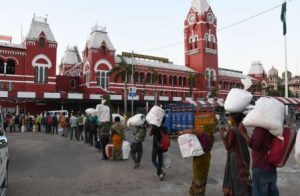Construction Workers – Reverse Migration 2021 Vs 2020
The second wave of COVID-19 is devastating – but this time, it has not caught the real estate sector completely unprepared. Developers learned many lessons from Lockdown 1.0.
unprepared. Developers learned many lessons from Lockdown 1.0.
No doubt, in the highly affected states in Maharashtra, the second lockdown has again caused an outward migration of construction labourers. The worst COVID-19-hit cities are Mumbai and Pune, where the bulk of real estate construction is underway. Nevertheless, the situation is not as grim as it was during the first lockdown.
In the Pune Municipal Region and Pimpri-Chinchwad Municipal Corporation, a large number of the migrant workers returning to their hometowns are from the hospitality and other services sectors. This is not surprising because hospitality has been hit very hard and its workers face an uncertain future.
It is impossible to predict when hotels, restaurants and resorts will be able to recover. With no revenues being generated, owners cannot afford to pay idle workers. Real estate, on the other hand, continues to sell. Recent reports by leading real estate consultancies confirm that in cities like Mumbai and Pune, no less than 65-70% of the pre-COVID-19 demand for housing has returned.
Also Read : India’s Migration Policy must Address Precise Processes of Exclusion; Say Experts
Since developers continue to generate revenues, they can also take many measures to assist their construction workers. Before the pandemic, over 43 million unskilled labourers were working in construction or building activity in India. Of this, more than 75% were migrant labourers from small towns and villages.
During the first lockdown, the fear of getting infected coupled with lack of work and affordable accommodation caused construction workers to abandon their sites and return home by any means available to them.
It was tragic and disheartening to witness. According to the Construction Workers Federation of India, over 70% of India’s migrant population went back to their hometowns in 2020. The real estate sector was caught unawares – developers lacked any prior knowledge and expertise to handle the situation.
By the time they began to improvise and re-strategize, most migrant workers had already left the cities. Thus, the impact of the pandemic on real estate construction was massive during the first wave.
Lockdown 2.0 – Lessons Learned and Implemented
During the current second wave, even as active cases have exceeded all calculations, the situation at construction sites is not as gloomy as it was in 2020. In the first place, there is no stringent lockdown across the country as was seen last year, when all construction work came to a total halt after the intense 21-day lockdown was announced.
At that time, millions of workers were left without work or wages. This time, in Maharashtra, construction using local labourers is allowed with provisos. Meanwhile, CREDAI (Confederation of Real Estate Developers Association of India) has assured construction workers not only of accommodation but also groceries, medical assistance and enhanced hygiene and safety.
Regular COVID-19 testing is being done at sites and even medical isolation facilities are available at many of them. Workers there have the assurance of immediate medical attention and daily site sanitation.
CREDAI has also announced that it would provide free vaccination to over 2.5 crore construction workers at the sites.
With over 13,000 developer members across 217 cities and towns, CREDAI had also petitioned the government to make all construction labourers over 21 years eligible for vaccination. In the most recent announcement, the government has cleared vaccinations for all aged 18 and above.
This effectively covers the entire construction sector and will be a massive relief to developers and construction workers alike.
These Days Will Also Pass
Currently, about 12-15% of the construction workers have left the sites to return home for the duration of the current lockdown. This is certainly lower than it was in 2020, and we do not expect the number to increase since the government’s support and preparedness of developers have had a positive impact.
Also, going by their own past experiences, many construction workers have realized that they are much better off in the cities than in their hometowns, where there are currently almost no employment opportunities.
In short, while it has slowed down during Lockdown 2.0 and the alarming rise of COVID-19 cases, construction continues in cities like Mumbai and Pune. Equally importantly, this construction activity is driven by actual demand since the pandemic has brought about a new awareness about the importance of housing.
Construction continues to be one of the largest employers of unskilled labour in the country. The desire to own homes has never been higher than during these pandemic times. Two positives can never result in a negative, so we expect things to normalize quickly once the current curbs are lifted.
